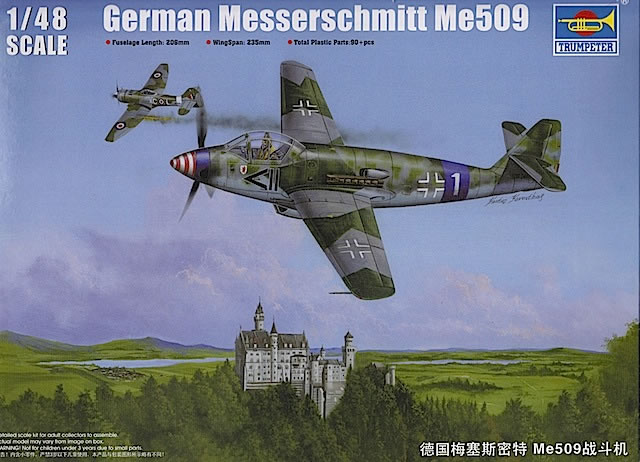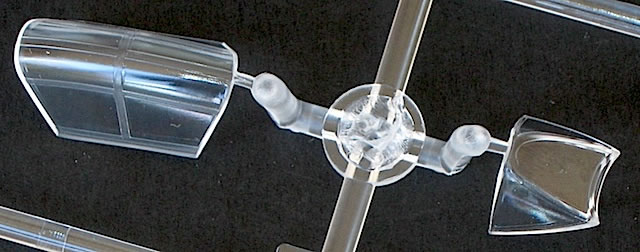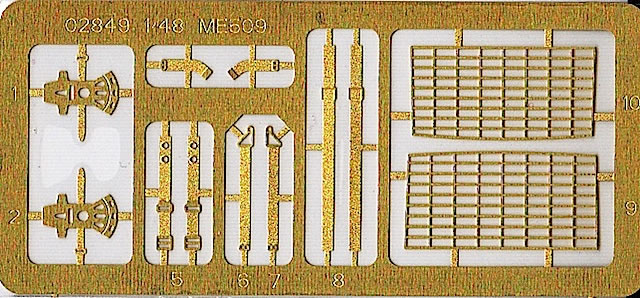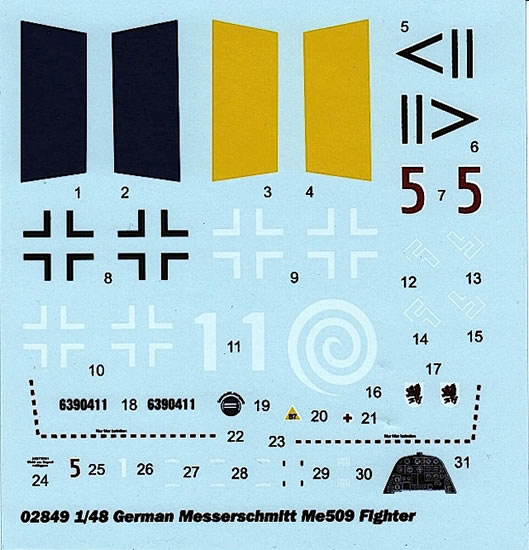Messerschmitt Me 509

Trumpeter, 1/48 scale
| S u m m a r y : |
Catalogue Number: |
Trumpeter kit no.02849 – Messerschmitt Me 509 |
Scale |
1/48 |
Contents and Media |
Approximately 73 mid-grey plastic parts; 6 clear plastic parts; 1 decal sheet containing markings for 2 fictional aircraft; 1 fret of photo-etched detail parts. |
Price |
Distributed in Australia by J.B. Wholesalers. Retail price around XXXX |
Review Type |
First Look |
Advantages |
Interesting subject; crisp mouldings; high level of detail |
Disadvantages |
Poor decals |
Conclusion |
Highly recommended to both ‘what if’ Luftwaffe enthusiasts and modelers wanting a straightforward build of an interesting subject. |
Reviewed by Brad Fallen

Trumpeter's 1/32 scale Messerschmitt Bf 109 E-4 is available online from
Squadron
The Messerschmitt Me 509 was a proposed development of the failed Me 309 program that never left the drawing board. Had it been built, the Me 509 would have sported a mid-fuselage DB605 engine in a layout similar to the P-39 Airacobra and twin-engined Dornier Do 335. The Me 509 design incorporated many features trialed on the Me 309 prototypes, such as a pressurised cockpit, ventral radiator and tricycle landing gear. But while the Me 309 was still clearly derived from the Bf 109, the family resemblance was less obvious in the Me 509. How the Me 509 would have fared – in terms of both design functionality and as a Luftwaffe weapon – had it been developed can only be speculated upon. In the event it was never to be, abandoned when the Me 309 program was cancelled in 1943.
For an aircraft that never existed, the Me 509 has been well served in model form. There have been at least two 1/72 kits – both resin, from RS Models and Wingnut International – and one 1/48 resin and white metal kit from Antares Models. But while the Antares kit, particularly, is a high quality limited run production, all of these kits are only suitable for experienced modelers.
This is where the Me 509 kit situation could reasonably have been expected to remain: a niche market for fans of the type who really want an example in their collections. Few would have expected to see a new tool injection moulded Me 509 from a major manufacturer, but Trumpeter obviously thought differently.
Trumpeter’s 1/48 Me 509 kit makes a dramatic first impression, with its box art of one of the kit subjects dispatching a radial-engined Tempest over a European castle. This positive feeling is reinforced by the overall high quality of the box contents. While the number of plastic parts is low – just under 80 on three grey sprues and one small clear sprue – moulding quality is good. Panel lines and access hatches are finely represented, and rivets are only present on a couple of panels beneath the wings. There are no sink marks and only a little flash on some parts.
Parts breakdown is conventional. The reasonably (if fictionally) detailed cockpit and nose wheel well are trapped between the two fuselage halves, and the wings and ventral radiator then build up around this. Unlike some Trumpeter kits, it is not over-engineered. The main wheel wells are a bit fiddly, with seven parts required to complete the sidewalls of each well. However, if you take your time, these fit together only a little fettling (I’ve already started construction), and you will end with deep, well detailed wheel bays.
The tricycle undercarriage legs are well moulded, looking both stalky and robust at the same time, and should be strong enough to support what will be a reasonably heavy model (I suspect a nose weight will be essential, although it isn’t mentioned in the instructions). For anyone worried that these parts won’t be up to the task, Scale Aircraft Conversions has already released a set of replacement white metal undercarriage for this kit.
The wheels are all two-part items with reasonable tread detail that should look OK when assembled. Again, aftermarket replacements are already available, this time from Mastercasters, who have also released a set of hollowed out exhausts to replace the solid kit items. However, I suspect that any aftermarket Bf 109 exhausts could also be made to fit.
Although it doesn’t look like it my photographs, the two-part canopy is very thin and clear. Special mention needs to be made of the packaging around the clear parts sprue: wrapped in thin foam and sealed in plastic film, there is no way this sprue was going to be damaged in transit.

Additional detail is provided through a small photo-etched fret, which contains an eight-part seat harness, two rudder pedals and two mesh grills. The latter will add essential detail to the big, one-piece radiator, which while carefully designed to avoid any ‘see-through’ effect is otherwise very plain.

Assembly instructions are clearly laid out in a black and white A4 booklet. The fact that there are only six steps in the assembly process reinforces the straightforward nature of the build. Colour call outs are provided throughout and are conventional for late war Luftwaffe fighters – for example, modelers are directed to paint the cockpit in RLM 66 Black Grey and the wheel wells in RLM 02 Grey.
Marking Options
The full colour, double-sided A4 painting and marking guide provides four view drawings of two fictional Luftwaffe Me 509s. One of these aircraft is finished in mid-war RLM 74 Grey Green and RLM 75 Grey Violet over RLM 76 Light Blue camouflage (with a curious mottling of RLM 66 on the upper fuselage), and the other in a later style RLM 75 and RLM 83 Dark Green over RLM 76 camouflage, with an RLM 82 Light Green fuselage mottle. The painting and marking guide includes comprehensive RLM colour call outs and equivalent Mr Hobby, Vallejo, Model Master and Tamiya paint references – an excellent touch that many other manufacturers would do well to adopt.

In contrast, the kit decals look to be quite poor. Printing is anything but crisp, and several multi-colour decals are out of register. The carrier film also has a blotchy appearance, as if it hasn’t quite attached itself to the printed markings. No swastikas are provided. Based on their appearance, I would be reluctant to use these decals.
Of course, because the Me 509 never existed, there are no rules on the scheme in which the model has to be completed. I’m planning on taking some liberties with history, and have ordered an LF Models decal sheet to complete the kit in the markings of W.Nr.415601/VD358 – one of two Bf 109 G-14s captured and repainted by the RAF and displayed at Farnborough in late 1945 (http://www.hannants.co.uk/product/LFMC4829).
This is a great if unexpected little kit from Trumpeter. Production quality is high, assembly looks like it will be straightforward, and because it’s a fictional subject, there are no questions about accuracy. The same goes for painting and finishing – while Trumpeter’s decals are disappointing, I cannot see why anyone would want to finish their model in one of the kit schemes when they can complete it in more or less any scheme that takes their fancy.
Trumpeter’s 1/48 Me 509 will be an essential purchase for many ‘what if’ Luftwaffe modelers. However, I also highly recommend it for anyone who wants an easy and interesting build, or needs a break from trying to accurately replicate late war Luftwaffe colour schemes.
Thanks to Trumpeter for the review sample.

Text and Images Copyright © 2012 by Brad Fallen
Page Created 30 August, 2012
Last updated
30 August, 2012
Back to HyperScale Main Page
|
